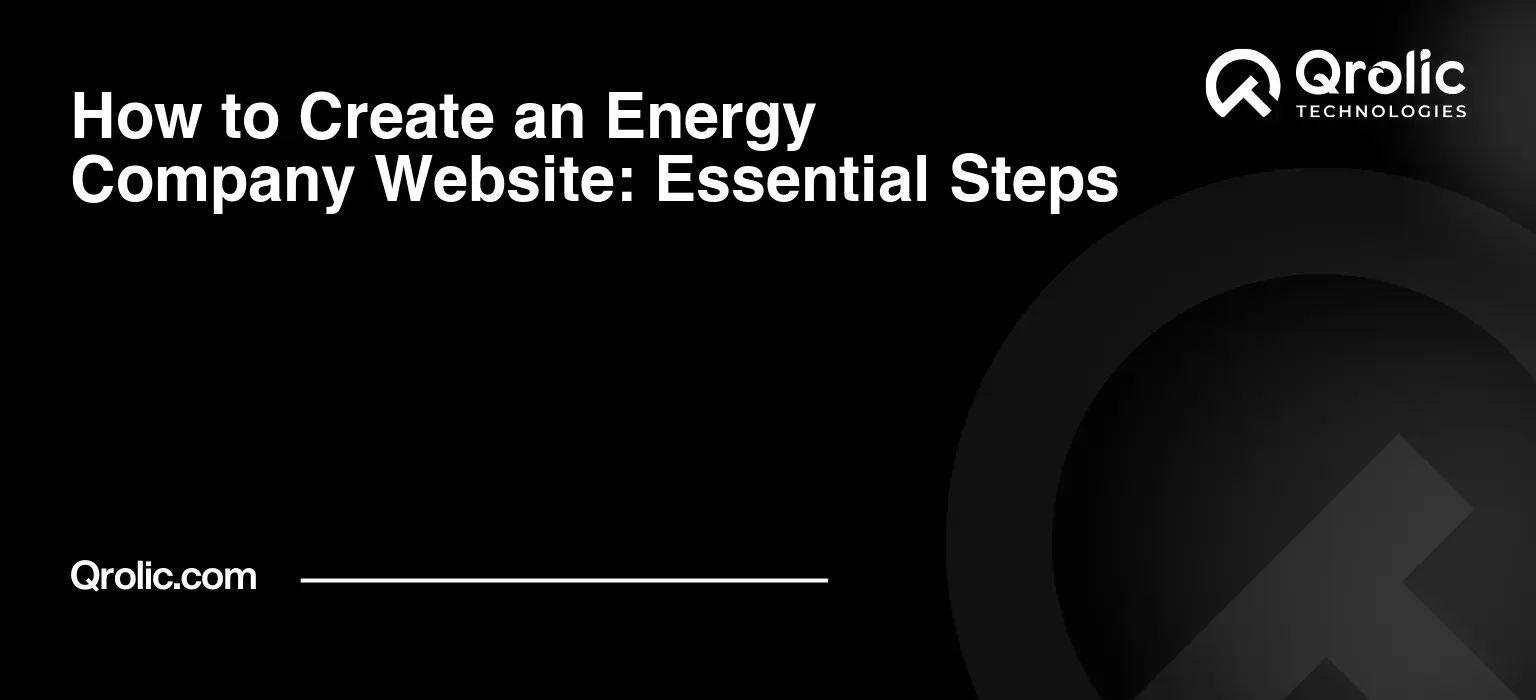Building an effective website for your energy company isn’t just about having an online presence; it’s about establishing trust, streamlining operations, and attracting new customers. In today’s digital age, your website is often the first point of contact for potential clients. Therefore, a user-friendly, informative, and visually appealing website is crucial for success. This comprehensive guide outlines the essential steps to creating an energy company website that achieves these goals.
Quick Summary:
- Clearly define website goals and target audience.
- Design with user-friendly navigation and engaging content.
- Integrate essential features like payments and support.
- Continuously test, secure, update, and market your site.
Table of Contents
- 1. Define Your Website’s Purpose and Goals
- 1.1. Identifying Core Objectives
- 1.2. Defining Your Target Audience
- 1.3. Establishing Key Performance Indicators (KPIs)
- 2. Choose a Domain Name and Web Hosting Provider
- 2.1. Selecting a Domain Name
- 2.2. Selecting a Web Hosting Provider
- 3. Plan Your Website Structure and Navigation
- 3.1. Creating a Site Map
- 3.2. Designing User-Friendly Navigation
- 3.3. Content Prioritization
- 4. Design Your Website’s Visual Appearance
- 4.1. Choosing a Color Palette
- 4.2. Selecting Fonts
- 4.3. Using High-Quality Images and Videos
- 4.4. Creating a Mobile-Responsive Design
- 4.5. Visual Hierarchy
- 5. Develop Engaging and Informative Content
- 5.1. Writing Clear and Concise Copy
- 5.2. Creating Engaging Visual Content
- 5.3. Optimizing Content for SEO
- 5.4. Address Key Customer Concerns
- 5.5. Highlight Sustainability Initiatives
- 6. Integrate Essential Features and Functionality
- 6.1. Online Bill Payment System
- 6.2. Energy Monitoring Tools
- 6.3. Customer Support Portal
- 6.4. Lead Capture Forms
- 6.5. Integration with CRM and Marketing Automation Systems
- 6.6. Security Measures
- 7. Test and Optimize Your Website
- 7.1. Website Usability Testing
- 7.2. Website Performance Testing
- 7.3. SEO Audits
- 7.4. Analytics Tracking
- 8. Ongoing Maintenance and Updates
- 8.1. Security Updates
- 8.2. Content Updates
- 8.3. Technical Maintenance
- 8.4. Regular Backups
- 9. Marketing and Promotion
- 9.1. Search Engine Optimization (SEO)
- 9.2. Social Media Marketing
- 9.3. Email Marketing
- 9.4. Paid Advertising
- 9.5. Content Marketing
- 10. Partnering with Qrolic Technologies for Your Energy Company Website
- 10.1. Qrolic’s Expertise in Utility Web Design
- 10.2. Comprehensive Services Offered by Qrolic
- 10.3. Benefits of Choosing Qrolic Technologies
- 10.4. Case Studies and Testimonials
- Conclusion
1. Define Your Website’s Purpose and Goals
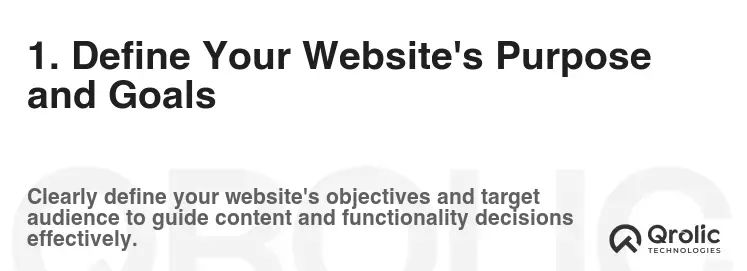
Before diving into design or development, clarity about your website’s purpose and objectives is paramount. What do you want to achieve with your online presence?
1.1. Identifying Core Objectives
- Lead Generation: Attract potential customers and gather their contact information.
- Customer Service: Provide online support, answer frequently asked questions, and offer self-service options.
- Brand Building: Establish your company as a reliable and trustworthy energy provider.
- Information Dissemination: Share information about your services, pricing, energy-saving tips, and company news.
- Online Bill Payment: Offer a convenient way for customers to pay their bills online.
- Energy Monitoring: Allow customers to track their energy usage and identify areas for improvement.
- Recruitment: Attract talented individuals to join your company.
1.2. Defining Your Target Audience
Understanding your target audience is critical for tailoring your website’s content and design. Consider the following:
- Residential Customers: Focus on affordability, energy efficiency, and ease of use.
- Commercial Customers: Emphasize reliability, cost savings, and customized energy solutions.
- Industrial Customers: Highlight scalability, sustainability, and advanced energy management systems.
- Age Demographics: Tailor the language and design to resonate with different age groups.
- Technical Proficiency: Adjust the level of technical detail based on your audience’s familiarity with energy concepts.
1.3. Establishing Key Performance Indicators (KPIs)
KPIs help you measure the success of your website. Define specific, measurable, achievable, relevant, and time-bound (SMART) goals.
- Website Traffic: Track the number of visitors to your website.
- Bounce Rate: Monitor the percentage of visitors who leave your website after viewing only one page.
- Conversion Rate: Measure the percentage of visitors who complete a desired action, such as filling out a contact form or signing up for a service.
- Customer Satisfaction: Gauge customer satisfaction through surveys and feedback forms.
- Online Bill Payment Adoption Rate: Track the percentage of customers who pay their bills online.
2. Choose a Domain Name and Web Hosting Provider

Your domain name is your online identity, and your web hosting provider is the foundation of your website.
2.1. Selecting a Domain Name
- Relevance: Choose a domain name that reflects your company name or the services you offer.
- Memorability: Opt for a short, easy-to-remember domain name.
- Availability: Check if the domain name is available and register it promptly.
- Extension: Consider using a .com, .net, or .org extension. You might also explore industry-specific extensions if available.
- Keywords: If possible, incorporate relevant keywords into your domain name to improve search engine optimization (SEO).
2.2. Selecting a Web Hosting Provider
- Reliability: Choose a provider with a proven track record of uptime and stability.
- Scalability: Ensure that the provider can accommodate your website’s growing needs.
- Security: Select a provider with robust security measures to protect your website from cyber threats.
- Customer Support: Look for a provider with responsive and knowledgeable customer support.
- Pricing: Compare pricing plans and choose one that fits your budget.
- Server Location: Choose a server location that is geographically close to your target audience to improve website loading speed.
- SSL Certificate: Ensure that the provider offers SSL certificates to encrypt data transmitted between your website and visitors.
- Types of Hosting: Shared, VPS, and Dedicated server options offer different levels of control and resources. Evaluate based on your needs.
3. Plan Your Website Structure and Navigation
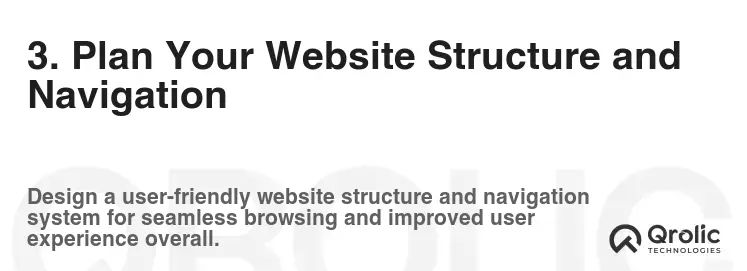
A well-structured website is easy to navigate and provides a positive user experience.
3.1. Creating a Site Map
A site map outlines the structure of your website and helps visitors find the information they need. Common pages for an energy company website include:
- Homepage: The main entry point to your website, providing an overview of your services.
- About Us: Information about your company’s mission, values, and history.
- Services: Details about the energy services you offer, such as electricity, natural gas, or renewable energy solutions.
- Pricing: Information about your pricing plans and rates.
- Energy Savings: Tips and resources for customers to reduce their energy consumption.
- Sustainability: Information about your company’s commitment to environmental responsibility.
- News & Events: Updates about your company’s activities and industry events.
- Customer Support: Contact information, FAQs, and online support resources.
- Careers: Job openings and information for potential employees.
- Contact Us: A form for visitors to contact you with inquiries.
- Blog: Share insightful articles, industry news, and energy-saving tips.
3.2. Designing User-Friendly Navigation
- Clear and Concise Labels: Use clear and concise labels for your navigation menu items.
- Logical Organization: Organize your content in a logical and intuitive manner.
- Dropdown Menus: Use dropdown menus to organize subpages under main navigation items.
- Search Functionality: Provide a search bar to allow visitors to quickly find specific information.
- Mobile-Friendly Navigation: Ensure that your navigation is easy to use on mobile devices.
- Breadcrumbs: Implement breadcrumbs to help users understand their location within the site.
3.3. Content Prioritization
Structure the website such that the most important content is easily accessible. Highlighting the benefits of your energy services upfront can significantly improve engagement.
4. Design Your Website’s Visual Appearance

The visual appearance of your website is crucial for creating a positive first impression and establishing brand credibility. Utility web design should be clean, modern, and reflect the company’s commitment to efficiency and reliability.
4.1. Choosing a Color Palette
- Brand Colors: Use your company’s brand colors to create a consistent visual identity.
- Accessibility: Ensure that your color palette meets accessibility standards for users with visual impairments.
- Industry Standards: Consider using colors associated with energy, such as blue (representing water or electricity) or green (representing renewable energy).
4.2. Selecting Fonts
- Readability: Choose fonts that are easy to read on screen.
- Consistency: Use a consistent font family throughout your website.
- Brand Personality: Select fonts that reflect your brand’s personality and tone.
4.3. Using High-Quality Images and Videos
- Professionalism: Use high-quality images and videos that are relevant to your content.
- Relevance: Choose images and videos that depict energy-related concepts, such as power plants, solar panels, or wind turbines.
- Originality: Avoid using stock photos that are overused. Consider using original photos and videos of your company’s operations.
- Optimization: Optimize images and videos for web use to reduce file size and improve loading speed.
4.4. Creating a Mobile-Responsive Design
- Mobile-First Approach: Design your website for mobile devices first, then adapt it for larger screens.
- Flexible Layouts: Use flexible layouts that adjust to different screen sizes.
- Touch-Friendly Navigation: Ensure that your navigation is easy to use on touchscreens.
- Fast Loading Times: Optimize your website for fast loading times on mobile devices.
- Testing: Regularly test your website on different mobile devices to ensure it is working properly.
4.5. Visual Hierarchy
Establish a clear visual hierarchy to guide users’ eyes to the most important information. Use headings, subheadings, and visual cues to create a logical flow.
5. Develop Engaging and Informative Content

Content is the heart of your website. It should be engaging, informative, and tailored to your target audience.
5.1. Writing Clear and Concise Copy
- Target Audience: Write in a language that your target audience understands.
- Benefits-Oriented: Focus on the benefits of your services rather than just the features.
- Call to Action: Include clear calls to action to encourage visitors to take the next step, such as “Get a Quote” or “Sign Up Now.”
- Proofread: Proofread your content carefully to ensure that it is free of errors.
- Keywords: Incorporate relevant keywords into your content to improve SEO, but avoid keyword stuffing.
5.2. Creating Engaging Visual Content
- Infographics: Use infographics to present complex information in a visually appealing format.
- Videos: Create videos that showcase your company’s services, explain energy concepts, or share customer testimonials.
- Interactive Content: Use interactive content, such as quizzes or calculators, to engage visitors and provide them with personalized information.
5.3. Optimizing Content for SEO
- Keyword Research: Conduct keyword research to identify the terms that your target audience is searching for.
- On-Page Optimization: Optimize your content for SEO by using relevant keywords in your page titles, headings, meta descriptions, and body text.
- Off-Page Optimization: Build backlinks to your website from other reputable websites.
- Schema Markup: Implement schema markup to provide search engines with more information about your content.
- Internal Linking: Link to other relevant pages on your website to improve SEO and user experience.
5.4. Address Key Customer Concerns
Proactively answer common questions about pricing, service reliability, and environmental impact. This builds trust and reduces customer service inquiries.
5.5. Highlight Sustainability Initiatives
With increasing environmental awareness, showcasing your company’s commitment to sustainability is crucial. Detail your efforts in renewable energy, energy efficiency, and reducing carbon footprint.
6. Integrate Essential Features and Functionality
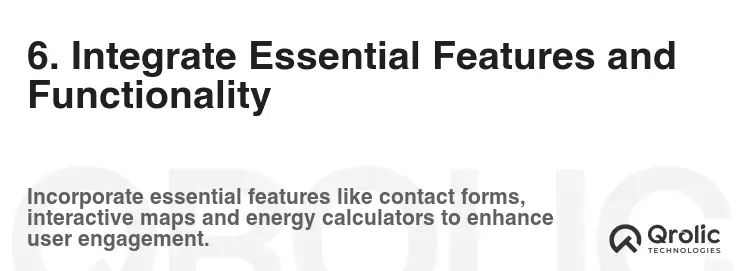
Essential features and functionality enhance the user experience and help you achieve your website’s goals.
6.1. Online Bill Payment System
- Secure Payment Gateway: Integrate a secure payment gateway to allow customers to pay their bills online.
- Payment Options: Offer a variety of payment options, such as credit cards, debit cards, and electronic checks.
- Payment History: Allow customers to view their payment history and download statements.
- Automatic Payments: Offer automatic payment options for convenience.
6.2. Energy Monitoring Tools
- Data Visualization: Provide customers with tools to visualize their energy usage data.
- Energy-Saving Tips: Offer personalized energy-saving tips based on their usage patterns.
- Usage Alerts: Send customers alerts when their energy usage exceeds a certain threshold.
- Comparative Analysis: Allow customers to compare their energy usage with that of similar households or businesses.
6.3. Customer Support Portal
- FAQ Section: Create a comprehensive FAQ section to answer common customer questions.
- Contact Form: Provide a contact form for customers to submit inquiries.
- Live Chat: Integrate a live chat feature to provide real-time support.
- Knowledge Base: Create a knowledge base with articles and tutorials on various energy-related topics.
6.4. Lead Capture Forms
- Contact Forms: Place contact forms strategically throughout your website to capture leads.
- Newsletter Sign-Up: Offer a newsletter sign-up form to build your email list.
- Free Resources: Offer free resources, such as e-books or webinars, in exchange for contact information.
6.5. Integration with CRM and Marketing Automation Systems
- Lead Management: Integrate your website with a CRM system to manage leads and customer data.
- Email Marketing: Integrate your website with a marketing automation system to send automated email campaigns.
- Personalization: Use customer data to personalize the website experience.
6.6. Security Measures
Implement robust security measures to protect your website from cyber threats. This includes:
- SSL Certificate: Install an SSL certificate to encrypt data transmitted between your website and visitors.
- Firewall: Use a firewall to protect your website from unauthorized access.
- Regular Backups: Regularly back up your website data to prevent data loss.
- Security Audits: Conduct regular security audits to identify and address vulnerabilities.
- Two-Factor Authentication: Implement two-factor authentication for administrative access.
7. Test and Optimize Your Website
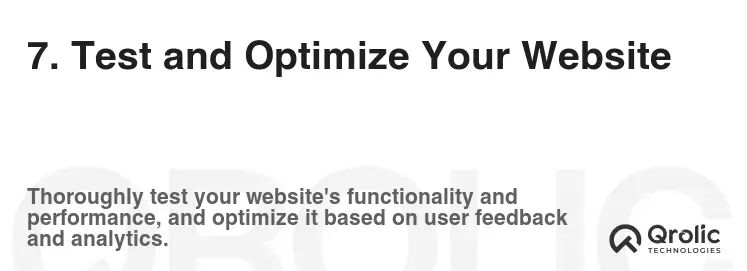
Testing and optimization are crucial for ensuring that your website is performing effectively.
7.1. Website Usability Testing
- User Testing: Conduct user testing with real users to identify usability issues.
- A/B Testing: Use A/B testing to compare different versions of your website and identify which performs better.
- Heatmaps: Use heatmaps to track where users are clicking and scrolling on your website.
- Surveys: Conduct surveys to gather feedback from users about their experience.
7.2. Website Performance Testing
- Loading Speed: Test your website’s loading speed and identify areas for improvement.
- Mobile Responsiveness: Test your website’s mobile responsiveness on different devices.
- Browser Compatibility: Test your website’s compatibility with different browsers.
7.3. SEO Audits
- Keyword Ranking: Track your website’s keyword ranking in search engines.
- Backlink Analysis: Analyze your website’s backlinks to identify opportunities for improvement.
- Technical SEO: Conduct a technical SEO audit to identify and fix technical issues that may be affecting your website’s ranking.
7.4. Analytics Tracking
- Google Analytics: Use Google Analytics to track website traffic, user behavior, and conversions.
- Data Analysis: Analyze your website data to identify trends and insights.
- Reporting: Create regular reports to track your website’s performance.
8. Ongoing Maintenance and Updates
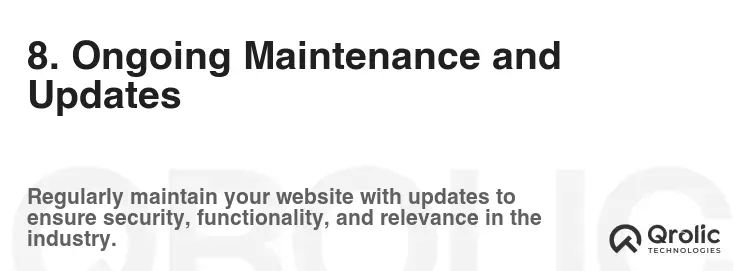
Website maintenance and updates are essential for keeping your website secure, functional, and up-to-date.
8.1. Security Updates
- Software Updates: Regularly update your website’s software, including your CMS, plugins, and themes.
- Security Patches: Apply security patches promptly to address vulnerabilities.
- Malware Scanning: Regularly scan your website for malware.
8.2. Content Updates
- Fresh Content: Regularly update your website with fresh content to keep it engaging and relevant.
- Blog Posts: Publish new blog posts regularly to attract visitors and improve SEO.
- News and Events: Keep your news and events section up-to-date with the latest information.
8.3. Technical Maintenance
- Broken Links: Fix broken links on your website.
- 404 Errors: Monitor for 404 errors and redirect them to relevant pages.
- Database Optimization: Optimize your website’s database to improve performance.
8.4. Regular Backups
Regularly back up your website data to prevent data loss in case of a disaster.
9. Marketing and Promotion
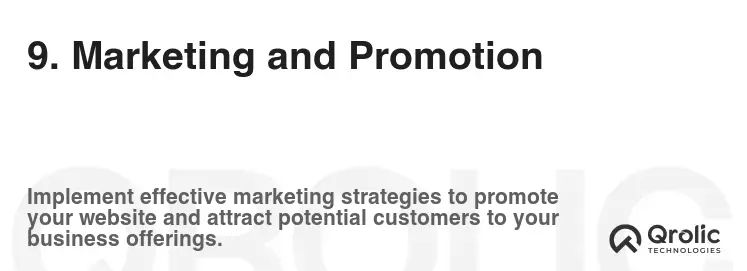
Having a great website is only half the battle. You need to market and promote it to attract visitors.
9.1. Search Engine Optimization (SEO)
- Keyword Research: Conduct keyword research to identify the terms that your target audience is searching for.
- On-Page Optimization: Optimize your content for SEO by using relevant keywords in your page titles, headings, meta descriptions, and body text.
- Off-Page Optimization: Build backlinks to your website from other reputable websites.
- Local SEO: Optimize your website for local search to attract customers in your area.
9.2. Social Media Marketing
- Social Media Presence: Create a presence on social media platforms that are relevant to your target audience.
- Engaging Content: Share engaging content on social media to attract followers and drive traffic to your website.
- Social Media Advertising: Use social media advertising to reach a wider audience.
9.3. Email Marketing
- Email List Building: Build an email list by offering valuable content or incentives in exchange for email addresses.
- Email Campaigns: Send targeted email campaigns to promote your services, share news and updates, and nurture leads.
- Email Automation: Use email automation to send automated emails based on user behavior.
9.4. Paid Advertising
- Google Ads: Use Google Ads to target potential customers who are searching for energy services online.
- Bing Ads: Use Bing Ads to reach a different audience than Google Ads.
- Social Media Ads: Use social media ads to target specific demographics and interests.
9.5. Content Marketing
- Blog Posts: Create valuable and informative blog posts that address the needs and interests of your target audience.
- E-books: Create e-books that provide in-depth information on energy-related topics.
- Webinars: Host webinars to educate your audience and establish your company as a thought leader.
10. Partnering with Qrolic Technologies for Your Energy Company Website

Creating and maintaining a high-quality energy company website can be complex and time-consuming. Partnering with a technology expert like Qrolic Technologies (https://qrolic.com/) can provide you with the expertise and support you need to succeed.
10.1. Qrolic’s Expertise in Utility Web Design
Qrolic Technologies specializes in utility web design and understands the unique challenges and opportunities in the energy industry. Their team of experienced designers, developers, and marketers can help you create a website that:
- Attracts and Engages Customers: Visually appealing and user-friendly design.
- Streamlines Operations: Integrated features for online bill payment, energy monitoring, and customer support.
- Improves SEO: Optimized for search engines to drive organic traffic.
- Is Secure and Reliable: Built with the latest security technologies and hosted on reliable infrastructure.
- Scalable and Flexible: Able to adapt to your changing business needs.
10.2. Comprehensive Services Offered by Qrolic
Qrolic Technologies offers a comprehensive suite of services to support your energy company’s online presence, including:
- Website Design and Development: Custom website design and development tailored to your specific needs.
- Content Management System (CMS) Implementation: Implementation of a user-friendly CMS, such as wordpress or Drupal, to manage your website content.
- E-commerce Integration: Integration of e-commerce functionality for online bill payment and other transactions.
- SEO Services: Search engine optimization services to improve your website’s ranking in search results.
- Social Media Marketing: Social media marketing services to promote your website and engage with your audience.
- Pay-Per-Click (PPC) Advertising: Pay-per-click advertising services to drive targeted traffic to your website.
- Website Hosting and Maintenance: Reliable website hosting and ongoing maintenance services to keep your website secure and up-to-date.
- Mobile App Development: Development of mobile applications for iOS and Android devices.
10.3. Benefits of Choosing Qrolic Technologies
Partnering with Qrolic Technologies offers numerous benefits, including:
- Industry Expertise: Deep understanding of the energy industry and its specific requirements.
- Custom Solutions: Tailored solutions to meet your unique business needs.
- Experienced Team: Team of experienced designers, developers, and marketers.
- Proven Track Record: Proven track record of delivering successful website projects.
- Ongoing Support: Ongoing support and maintenance to keep your website running smoothly.
- Increased ROI: Improved website performance and increased return on investment.
10.4. Case Studies and Testimonials
Review case studies and testimonials from other energy companies that have partnered with Qrolic Technologies to see how they have helped them achieve their online goals.
Conclusion
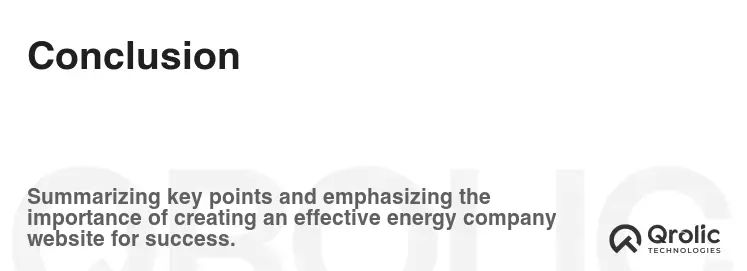
Creating a successful energy company website requires careful planning, design, development, and ongoing maintenance. By following the essential steps outlined in this guide, you can build a website that attracts customers, streamlines operations, and establishes your company as a leader in the energy industry. Consider partnering with Qrolic Technologies to leverage their expertise and ensure your website achieves its full potential. This detailed guide provides a foundation for building an effective online presence, driving growth, and fostering customer trust in the competitive energy market. Remember that adaptability and continuous improvement are key to maintaining a successful website in the long term. Your energy company website is a dynamic tool that should evolve alongside your business and the needs of your customers.
